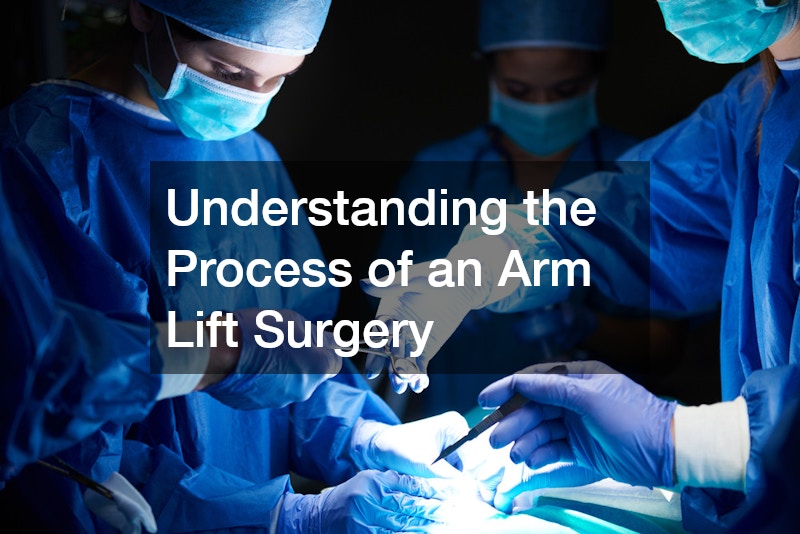An arm lift surgery, also known as brachioplasty, is a cosmetic procedure aimed at removing excess skin and fat from the upper arms. Take an in-depth look at the process, and understand the common questions and concerns associated with the surgery. As people age, experience significant weight loss, or struggle with genetics, the skin around the arms can lose its elasticity, leading to sagging or what is often referred to as “bat wings.” While diet and exercise can help build muscle and reduce some fat, they cannot fully address loose or stretched skin.
Arm lift surgery offers a solution for those seeking a more defined, youthful contour.
What Is Arm Lift Surgery?
Arm lift surgery, or brachioplasty, specifically targets the upper arms to address sagging skin and fat accumulation. As individuals age, the skin can lose elasticity, which leads to a drooping appearance that can be exacerbated by significant weight loss. This procedure not only enhances the aesthetic contour of the arms but also promotes renewed self-confidence for many patients.
The primary goal of arm lift surgery is to create a firmer and more toned look. During the procedure, the surgeon will make an incision on the inner part of the arm, where excess skin and fat are removed. This incision is typically positioned in a way that minimizes visible scarring. For candidates looking to improve their appearance significantly, this surgery often serves as an effective solution.
Candidates can expect to undergo a thorough evaluation before the surgery, typically involving a discussion about their medical history and aesthetic goals. The consultation process is essential for determining the appropriate technique to be used. Patients should also have realistic expectations regarding the outcomes and understand that recovery will vary from person to person.
Who are the Ideal Candidates for an Arm Lift?
Ideal candidates for arm lift surgery generally include individuals who are physically healthy and at a stable weight, yet struggle with skin laxity or excess fat in the upper arms. Many find themselves with sagging skin after significant weight loss, pregnancy, or simply as a result of aging. A thorough pre-surgery evaluation will help assess whether this procedure is appropriate for them.
Another critical consideration for arm lift candidates is their lifestyle and the commitment to maintaining a healthy regimen post-surgery. Patients need to be aware that the results will depend significantly on their weight stability and exercise habits. Therefore, candidates should ideally be dedicated to exercising and maintaining a balanced diet to sustain their results.
Moreover, having realistic expectations about the results is crucial. While an arm lift can enhance the appearance of the arms, the degree of change varies per individual. Engaging openly with their surgeon about desired outcomes will help ensure that patients receive tailored advice and recommendations based on their unique situations.
What is the Procedure Like?
The arm lift procedure is typically performed under general anesthesia or local anesthesia with sedation, depending on the extent of surgery planned and the patient’s comfort level. Before the surgery begins, the surgeon will mark the areas to be treated, allowing for precise excision of excess skin and fat. The procedure duration varies, commonly ranging from two to four hours.
During the surgery, the surgeon makes incisions based on the amount of excess skin and fat present. For patient comfort, care is taken to minimize the visibility of incisions, often placing them in discreet areas of the arm. After removing the excess tissue, the surgeon will then reposition the skin and sew up the incisions, creating a smoother contour.
Following the completion of surgery, patients are moved to a recovery area for monitoring. Initial recovery may involve some discomfort, swelling, and bruising, which is part of the natural healing process. Surgeons typically provide post-operative care instructions to manage pain and expedite recovery.
What is the Recovery Process After an Arm Lift?
The recovery process after arm lift surgery involves several stages and can vary from person to person. Initially, patients may experience discomfort, swelling, and bruising for a few weeks, requiring rest and limited activities. Surgeons provide patients with recommendations for managing pain and optimizing recovery, including prescribed medications.
Patients will also wear compression garments to minimize swelling and support the healing process. It is essential to follow the surgeon’s instructions regarding activity restrictions and follow-up appointments to monitor the healing progress. Most patients can return to daily activities within a few weeks, but should avoid strenuous exercise for several weeks or as advised.
During follow-up visits, the surgeon will assess the healing progress and can provide guidance on resuming normal activities. Many individuals report significant improvements in their arm appearance after a few months, and following their surgeon’s advice can contribute to achieving the best long-term results. Patience during this phase is important, as full results can take time to be visible.
Arm lift surgery can significantly enhance the appearance of the upper arms. By understanding the process, candidates can make informed decisions and approach the surgery with confidence. With careful consideration and the right expectations, individuals can achieve flattering and lasting results that improve their self-image.


